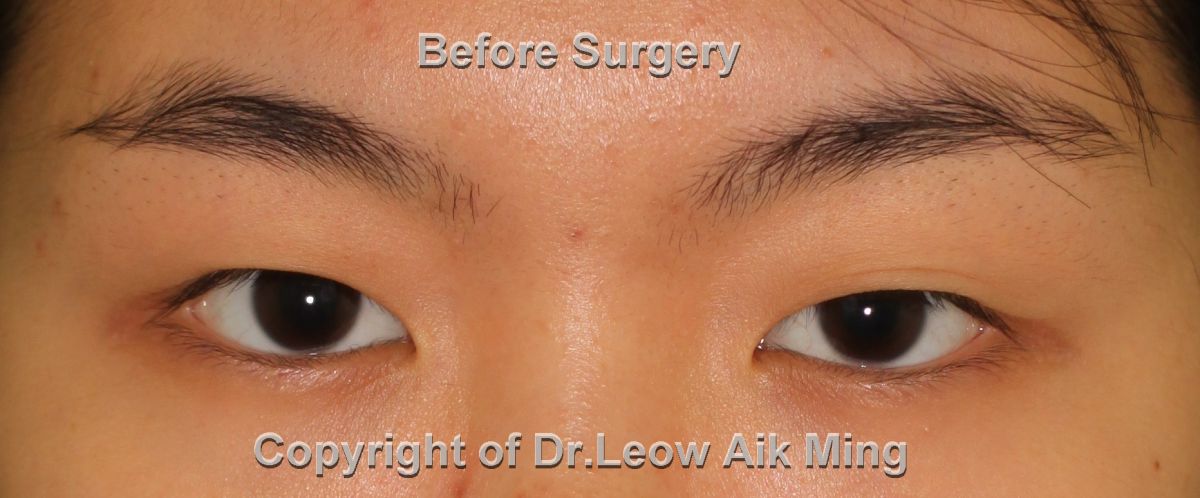The presentation of eyelid creases in Asian varies from one person to another. About 50% of Asians are born with eyes that have “single eyelids or monolids,” which has no distinctive upper eyelid creases when the eyes are open. Asian eyes vary in terms of the epicanthal fold, amount of skin, fat and other important structural elements. Rarely, two different kinds of eyelid creases may present in an individual.
There are six different types of Oriental eyelid creases:
(1) Absent eyelid crease:
This condition is also known as the monolid or single eyelid crease because no definitive eyelid crease separates the upper eyelid into two parts.
(2) Partial eyelid crease:
There is a crease but it is not well defined or it may not extend entirely across the eyelid. With age, the partial crease can become more defined as the skin above the crease becomes looser.
(3) Tapering eyelid crease with or without lateral flare:
A tapering crease becomes narrower toward the inner corner of the eye. Sometimes the outer part (lateral part) of the eyelid fold is wider than the central part.
(4) Hooded eyelid crease:
In this condition, an extra layer of skin droops over the eyelid crease on the outer corners of the eye causes the eye appears smaller and sometimes, sleepier. It is also commonly seen in the elderly as the skin begins to droop.
(5) Parallel eyelid crease:
The inner corner of the crease does not narrow as a tapering eyelid crease does.
(6) Multiple eyelid creases:
The presence of multiple distinct skins folds in the eyelid crease.
Double eyelid surgery or Asian blepharoplasty is a cosmetic surgical procedure aims to create a natural crease in the eyelid that appears when the eyes are opened, but not when they are closed. There are two types of Asian blepharoplasty namely the incisional (open) or non-incisional (stitch) method. There is no single procedure that fits all. Therefore, the selection of the surgical method is determined by the patient’s age and gender, thickness and quality of the upper eyelid skin, fat volume and unique anatomy around the eyes. Occasionally, epicanthoplasty can be incorporated with Asian blepharoplasty to change the epicanthal fold (mongoloid fold) so that the inner corner of the eye (inner canthus) is exposed. Thus, the upper eyelid crease may appear longer and the eye may appear wider.
Ideal candidates for Asian blepharoplasty
- Healthy individuals who do not have a life-threatening illness or medical conditions that can impair healing
- Individuals with a positive outlook and specific goals in mind for eyelid surgery or blepharoplasty
- Individuals without serious eye conditions
- Non-smokers.
Preoperative evaluation for Asian blepharoplasty
Communication is vital to achieving the patient’s goals. During the initial consultation, patients will have the opportunity to discuss their goals and desired results with the plastic surgeon. The plastic surgeon will work closely with the patients to reach an agreement about the expectations from the surgical procedures involved and their long term benefits. Every patient is different, therefore a specific treatment regimen is planned to suit an individual’s need.
- Discussion about patients’ expectations and desired outcome
- Medical conditions, drug allergies and previous medical or surgical treatment
- Use of current medications, vitamins, herbal supplements, alcohol, tobacco and drugs
- Discussion of type of anaesthesia
- Examination of the face and periorbital area
- Photography for preoperative and postoperative evaluation.
Preparation for Asian blepharoplasty
- Get laboratory testing or a medical evaluation
- Adjust your medications if you have certain medical conditions
- Stop smoking and alcohol well in advance of the scheduled date for surgery
- Avoid taking aspirin, anti-inflammatory drugs and herbal supplements before surgery.
The risks and safety information on Asian blepharoplasty
It is important for patients to understand that every surgical procedure has its complications and downtime. However, if a patient is assessed properly before the surgery and postoperative care is given adequately, these risks can be eliminated or reduced.
Some of the common risks of Asian blepharoplasty:
- Infection
- Bleeding
- Poor wound healing
- Skin discolouration
- Swelling due to a blood clot or fluid accumulation
- Scarring
- Temporary numbness at operated sites
- Asymmetry
- Possibility of revision surgery
- Anaesthesia risks.
Postoperative expectations
After the surgery there may be swelling, bruises, discomfort, irritation or dry eyes for several days that can be controlled with oral medications, cold compression, eye drops and ointment. Oral antibiotics and analgesics will be prescribed to reduce the risk of infection and postoperative pain respectively. Stitches will be removed 5-7 days after the surgery. The final result of surgery will appear within several weeks, but it may take up to a year for incision lines to fully refine.
Case No. 1:

Case No. 2:


Case No. 3:


Postoperative care
- Keep your head elevated especially when sleeping for several days
- Regular application of antibiotic ointment and cold compression around the operated areas
- Avoid strenuous physical activities for two weeks
- Wear sunglasses to protect eyes
- Do not wear contact lenses after surgery unless directed by a physician.
How much will an Asian blepharoplasty surgery cost?
Cost is always a consideration in elective surgery. The cost of eyelid surgery can vary widely.
The cost of blepharoplasty surgery may include:
- Surgeon’s fee
- Hospital or surgical facility costs
- Anaesthesia fees
- Prescriptions for medication, and
- Medical tests
Most health insurance companies do not cover cosmetic surgeries or complications. However, when eyelid surgery is performed for the reconstructive purpose to eliminate the redundant skin covering the eyelashes (ptosis), it may be covered by insurance. Carefully review your policy or find out more from your medical insurance agent.
